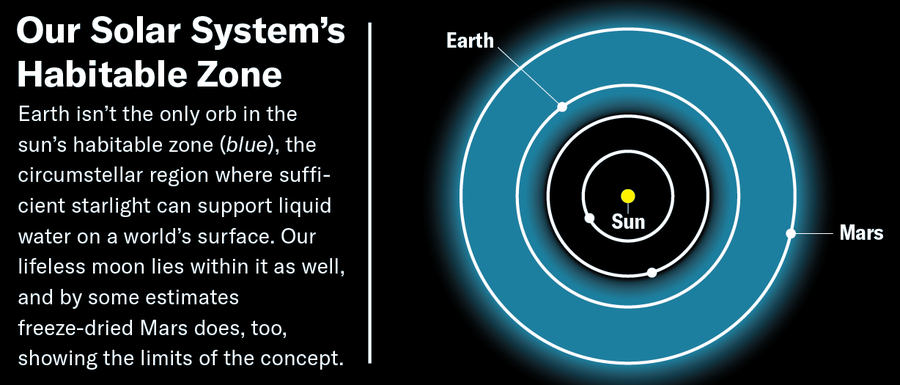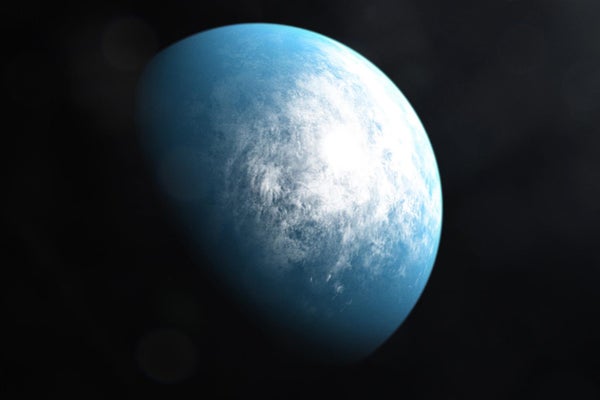Astronomers have, so far, discovered nearly 5,500 exoplanets—alien worlds orbiting alien stars—with more than 7,000 candidate planets still waiting to be confirmed.
That's a lot of planets.
We search for these distant worlds because we're curious and want to know what other planets are like. By understanding other worlds, we can better understand our own. But make no mistake, scientists are humans, and we want the answer to one of the biggest questions of the scientific age: Are we alone?
On supporting science journalism
If you're enjoying this article, consider supporting our award-winning journalism by subscribing. By purchasing a subscription you are helping to ensure the future of impactful stories about the discoveries and ideas shaping our world today.
We may get an answer soon. Our technology is just on the cusp of detecting exoplanetary biosignatures, telltale signs of life such as molecules in planetary atmospheres that could indicate the presence of biology. Until then, though, it's useful to investigate everything we can about these planets and categorize them by their likelihood of supporting life.
A handy concept astronomers have for this is called the habitable zone. This is a region around a star where temperatures allow a planet to potentially harbor oceans, seas or lakes of liquid water on its surface. Too close and the stellar heat boils the water off. Too far and it freezes. Between these extremes, though, it could be just right. This middle-ground aspect is why some astronomers refer to it as the Goldilocks zone. (Although, to be honest, I've never cared for this moniker; I'd opt for the Baby Bear zone. Naming it after the person who broke into that ursine home and usurped all their hard-won food and property smacks of colonialism.)
As an idea, it's pretty useful. All life on Earth needs liquid water, and because we're unaware as yet of any other way life might occur, that's a good place to start.
Measuring habitable zones, however, isn't straightforward. Calculating the radiation a planet receives from its star is easy; that depends on well-understood physics. The hard part is the planet itself. A dark planet absorbs more light and heats up, whereas a lighter-toned one will reflect more light and be colder.
A planet's atmosphere plays an even bigger role: if it's loaded with greenhouse gases, then the planet needs to be farther out from the star to be clement. Just look at Venus—our sibling world in many ways, similar to Earth in size and mass—to see how important that is. Lead would melt on our evil twin's surface because of its overwhelmingly thick atmospheric blanket of carbon dioxide. It's not exactly an Earth-like planet.
So on its own, finding a planet in a star's nominal habitable zone is no guarantee it will be, well, habitable, even if it's a small (and presumably) rocky world like our own. A lot more must be known, including whether it even has an atmosphere, what that atmosphere is composed of, and more. This problem is so complicated that astronomers argue over where our sun's habitable zone even starts, and we're literally inside it. What's more, the habitable zone might not be the only place where liquid water can exist in a solar system.
In the 1970s the Voyager 2 spacecraft flew by Jupiter's moon Europa and saw surface features that hinted at the presence of a liquid-water ocean underneath its frozen surface. We've since collected extremely compelling evidence of subsurface Europan liquid water kept warm by the moon's interaction with Jupiter's immense gravity.
Europa isn't the only ocean moon, either. In 2005 images from the Cassini spacecraft showed huge plumes of water erupting off the surface of Saturn's icy moon Enceladus. Probably generated by Saturn's tidal activity, similar to what warms Europa, these geysers point to the presence of immense pockets of subsurface liquid water, if not another ocean.

Credit: Jen Christiansen
Now we think there could be many such sub-ice oceans inside the moons of the solar system's outer planets and even in some of the larger objects orbiting the sun past Neptune.
In fact, we know of quite a few rogue planets meandering through interstellar space, which were probably ejected from their original planetary systems as the worlds there first formed and gravitationally interacted with one another. The ones we find tend to be gas giants even more massive than Jupiter. If they have icy moons, those, too, could be heated enough to have subsurface oceans. So you might not even need to have a star to have a habitable world!
To throw even more cold water on habitable zones, there are other liquids to ponder as well. Saturn's largest moon Titan is too cold to have liquid water on its surface, but Cassini observations in 2006 showed vast lakes of liquid methane there. Methane is a carbon-based molecule, so many of the ingredients for life are perforce there. Who knows whether there are alien fishies swimming in Titanic lakes a billion kilometers from the sun?
Needless to say, these are well outside the sun's quote-unquote habitable zone, yet it's possible that life may abound inside these prima facie frozen moons. Clearly, the concept of a habitable zone is woefully incomplete for the purpose of determining where life might exist. So is it time to kick it to the galactic curb?
Let's not throw out the extraterrestrial baby with the subsurface bathwater! Some years ago a team of planetary astronomers wrote that the term needs modifying and suggested it be replaced with “temperate zone.” I think this idea is a fine one, still highly useful if we're looking for Earth-like planets, which, to be clear, we are. It might not include frozen moons of gas-giant planets or worlds where life as we don't know it may evolve, but as long as we are aware of these limitations, it's still handy. Renaming the concept could solve some things.
The habitable zone, even by any other name, was never meant to be an ironclad rule. It was always a guideline, an idea to inform astronomers that they might be onto something interesting when a planet is found in a certain spot. It's not a device for measuring potentially habitable worlds so much as a way to bookmark them for future observations.
It's easy to want to draw lines in the sand—a planet this far from its star is inhospitable, but a planet that far is great—but nature almost never behaves that way. It generally works on a spectrum, with fuzzy borders and even larger overlaps. It's always good to keep that in mind when reading about scientific discoveries.
A planet being in its star's habitable zone might not be sufficient, or even necessary, to make it habitable, but it's still a pretty good place to start when looking for life. We just need to make sure we don't stop there.
